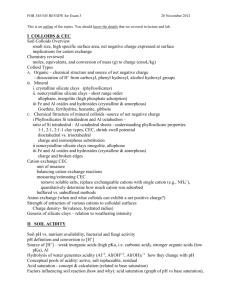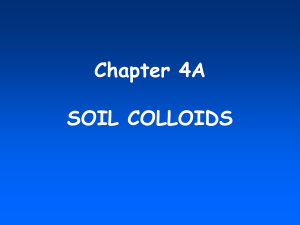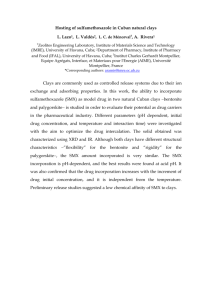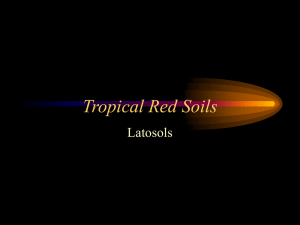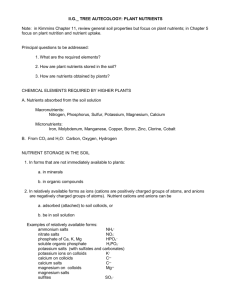Soil Colloids : Chapter 8
advertisement
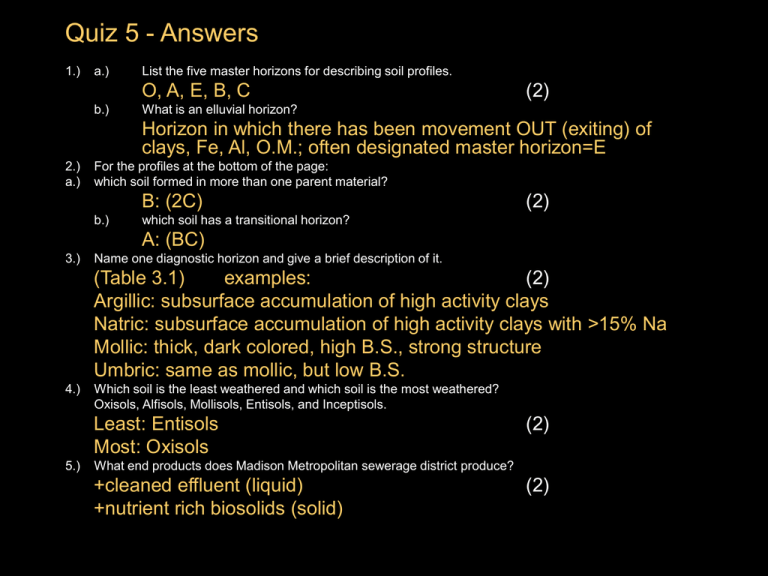
Quiz 5 - Answers 1.) a.) List the five master horizons for describing soil profiles. O, A, E, B, C b.) (2) What is an elluvial horizon? Horizon in which there has been movement OUT (exiting) of clays, Fe, Al, O.M.; often designated master horizon=E 2.) a.) For the profiles at the bottom of the page: which soil formed in more than one parent material? B: (2C) b.) (2) which soil has a transitional horizon? A: (BC) 3.) Name one diagnostic horizon and give a brief description of it. (Table 3.1) examples: (2) Argillic: subsurface accumulation of high activity clays Natric: subsurface accumulation of high activity clays with >15% Na Mollic: thick, dark colored, high B.S., strong structure Umbric: same as mollic, but low B.S. 4.) Which soil is the least weathered and which soil is the most weathered? Oxisols, Alfisols, Mollisols, Entisols, and Inceptisols. Least: Entisols Most: Oxisols 5.) (2) What end products does Madison Metropolitan sewerage district produce? +cleaned effluent (liquid) +nutrient rich biosolids (solid) (2) Soil Colloids : Chapter 8 Primary Minerals • Table 2.2 and Figure 2.4 • Remember definition of mineral – general adjective to describe inorganic materials derived from rocks • ex: silicate clays – specific noun to refer to distinct minerals found in nature • ex: quartz, feldspar Definitions • colloids: organic and inorganic matter with very small particle size and a correspondingly large surface area per unit of mass • silicate clay: colloid with Si in framework • nonsilicate clay: colloid withOUT Si in framework • humus: more or less stable fraction of the soil O.M. remaining after the major portions of added plant and animal residues have decomposed Definitions • exchangeable ions: – cations: Al3+, Ca2+, Mg2+, K+, H+, Na+ – anions: Cl-, NO3-, SO42- • crystal structure: the orderly arrangement of atoms in a crystalline material • amorphous: noncrystalline Important Properties of Soil Colloids • Size • Surface Area • Surface Charge • Cation/Anion Exchange Four Major Types of Soil Colloids • Inorganic – 1) crystalline silicate clays – 2) non-crystalline silicate clays – 3) Fe/Al oxides (non silicate clays) • Organic – 4) humus Structure of Soil Colloids • Silicate clays Fig 8.4 Building Blocks – tetrahedral • 4-sided • 1 Si, 4 O – octahedral • 8-sided • trioctahedral: 6O with 3 Mg2+ • dioctahedral: 6O with 2 Al3+ Fig. 8.4 Isomorphic Substitution • Definition: the replacement of one atom by another of similar size in a crystal lattice without disrupting or changing the crystal structure of the mineral • Table 8.2 • in tetrahedral sheets: – expected ions: Si4+ – potential replacement ions: Al3+, Fe3+ • in octahedral sheets: – expected ions: Al3+, Mg2+ – potential replacement ions: Al3+, Fe3+, Mg2+, Zn2+, Fe2+ Structure of Soil Colloids • Nonsilicate clays = Fe/Al Oxides – no Si – octahedral only (no tetrahedral) – little isomorphic substitution – small negative, sometimes positive charge • Humus – noncrystalline – large organic molecule (C, O, H, N) – net negative charge – Fig. 8.13 Genesis of Soil Colloids • alteration • decomposition and recrystallization **parent material and weathering conditions** Soils: An Introduction (Singer and Munns)
